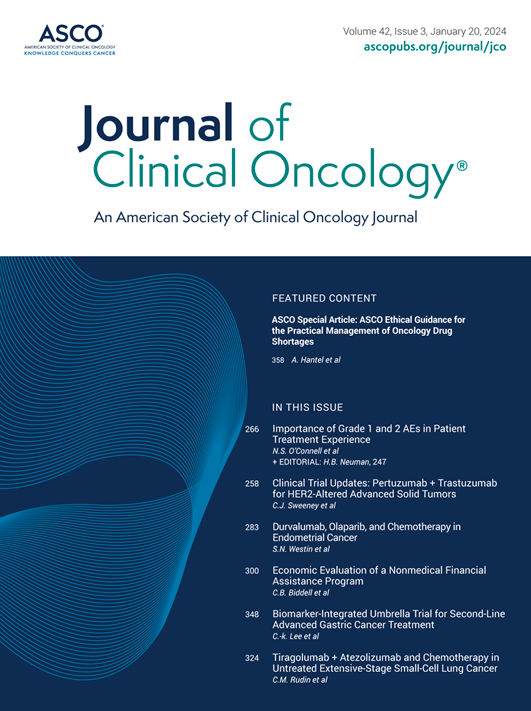造血干细胞移植患者住院姑息治疗干预的多地点随机试验。
IF 41.9
1区 医学
Q1 ONCOLOGY
引用次数: 0
摘要
目的:接受造血干细胞移植(HSCT)的患者及其护理人员承受巨大的身体和心理症状,导致HSCT期间的生活质量(QOL)下降。方法:我们在三个学术机构进行了一项多地点随机试验,研究对象是接受自体或同种异体造血干细胞移植的成年人。患者被随机分配到住院姑息治疗(PC)干预组或常规护理组。干预患者在HSCT住院期间每周两次与PC临床医生会面。分配到常规护理的患者可以根据护理标准转到PC。我们评估患者的生活质量:肿瘤治疗-骨髓移植功能评估;照料者:照料者-肿瘤-生活质量)、抑郁和焦虑症状(医院-焦虑和抑郁量表)以及患者创伤后应激障碍(PTSD)症状(创伤后应激障碍检查表)在hsct后的基线、第2周、第3和6个月。主要终点是患者在住院第2周时的生活质量,此时患者的生活质量处于最低点。我们使用线性回归,调整基线评分,评估干预对第2周患者报告结果的影响。我们使用线性混合效应模型来纵向评估干预对研究结果的影响。结果2018年10月至2022年7月,我们纳入了68.7%(360/524)的符合条件的患者。与接受常规护理的患者相比,接受干预的患者生活质量更好(调整后平均差值[B], 6.3;, 0.1;P < 0.001),抑郁程度较低(B, -1;, 0.4;P = 0.026), PTSD症状较少(B, -1.9;, 0.9;P = .046)。在第2周,患者报告的焦虑在两组之间没有显著差异。在纵向分析中,接受干预的患者报告在hsct后6个月内PTSD症状的急剧下降(斜率差为-0.9;, 0.7;P = .012)。所有其他患者报告的结果在两组之间没有纵向差异。结论pc可显著改善患者的生活质量、抑郁和PTSD症状,且对PTSD症状的影响持续至hsct后6个月。本文章由计算机程序翻译,如有差异,请以英文原文为准。
Multisite Randomized Trial of Inpatient Palliative Care Intervention for Patients Undergoing Hematopoietic Stem Cell Transplantation.
PURPOSE
Patients undergoing hematopoietic stem cell transplantation (HSCT) and their caregivers endure immense physical and psychological symptoms, which result in quality-of-life (QOL) impairments during HSCT.
METHODS
We conducted a multisite randomized trial among adults undergoing autologous or allogeneic HSCT at three academic institutions. Patients were randomly assigned to an inpatient palliative care (PC) intervention or usual care. Intervention patients met with PC clinicians twice weekly during the HSCT hospitalization. Patients assigned to usual care could be referred to PC as per standard of care. We assessed QOL (patient: Functional Assessment of Cancer Therapy-Bone Marrow Transplant; caregiver: Caregiver-Oncology-QOL), depression and anxiety symptoms (Hospital-Anxiety-and-Depression-Scale), and patients' post-traumatic stress disorder (PTSD) symptoms (PTSD Checklist) at baseline, week 2, and 3 and 6 months post-HSCT. The primary end point was patients' QOL at week 2 during hospitalization when patients experience their QOL nadir. We used linear regression, adjusting for baseline scores, to evaluate the effect of the intervention on patient-reported outcomes at week 2. We used linear mixed-effect models to assess the effect of the intervention on study outcomes longitudinally.
RESULTS
We enrolled 68.7% (360/524) of eligible patients between October 2018 and July 2022. Compared with those receiving usual care, patients receiving the intervention reported better QOL (adjusted mean difference [B], 6.3; SE, 0.1; P < .001), lower depression (B, -1; SE, 0.4; P = .026), and fewer PTSD symptoms (B, -1.9; SE, 0.9; P = .046) at week 2. Patient-reported anxiety did not differ significantly between groups at week 2. In longitudinal analyses, patients receiving the intervention reported a steeper decline in PTSD symptoms over 6 months post-HSCT (slope difference, -0.9; SE, 0.7; P = .012). All other patient-reported outcomes did not differ longitudinally between the groups.
CONCLUSION
PC led to substantial improvements in patients' QOL, depression, and PTSD symptoms with sustained effects on PTSD symptoms up to 6 months post-HSCT.
求助全文
通过发布文献求助,成功后即可免费获取论文全文。
去求助
来源期刊

Journal of Clinical Oncology
医学-肿瘤学
CiteScore
41.20
自引率
2.20%
发文量
8215
审稿时长
2 months
期刊介绍:
The Journal of Clinical Oncology serves its readers as the single most credible, authoritative resource for disseminating significant clinical oncology research. In print and in electronic format, JCO strives to publish the highest quality articles dedicated to clinical research. Original Reports remain the focus of JCO, but this scientific communication is enhanced by appropriately selected Editorials, Commentaries, Reviews, and other work that relate to the care of patients with cancer.
 求助内容:
求助内容: 应助结果提醒方式:
应助结果提醒方式:


